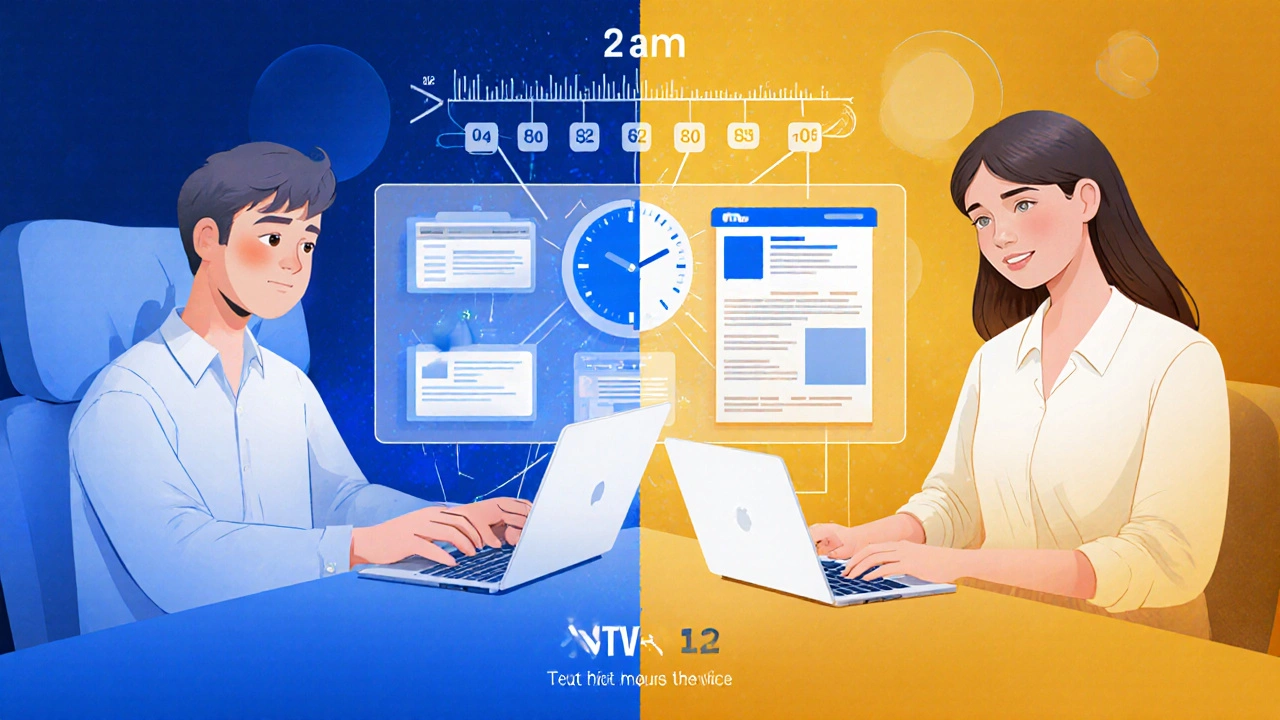ChatGPT Prompt Effectiveness Calculator
Analyze how effective your ChatGPT prompts are for marketing content. Based on real-world best practices from 2024 marketing teams, this calculator identifies key weaknesses and provides actionable improvements.
Specificity
Does your prompt include details like tone, audience, length, and context?
Brand Voice
Does your prompt define your brand's unique voice and style?
Fact-Checking
Does your prompt require verification of facts and data?
Key Improvement
Enter your prompt and click "Analyze Prompt" to see suggestions.
Five years ago, marketers spent hours writing email subject lines, drafting social posts, and tweaking ad copy. Today, many of those tasks take under a minute - thanks to ChatGPT. It’s not just a tool anymore. It’s become part of the team. Companies using ChatGPT for content creation are seeing 40% faster turnaround times, according to a 2024 survey of 1,200 marketing teams across North America and Australia. That’s not hype. That’s real efficiency.
ChatGPT Isn’t Replacing Marketers - It’s Handling the Grind
Let’s be clear: ChatGPT won’t replace your best campaign strategist. But it will take over the boring, repetitive stuff. Think of it like a junior copywriter who never sleeps, never gets tired, and doesn’t mind rewriting the same headline 27 times.
Marketers now use ChatGPT to generate:
- 10 variations of a product description in under 30 seconds
- LinkedIn posts tailored to different buyer personas
- Email drip sequences based on customer behavior
- Meta and Google ad copy optimized for CTR
- FAQ sections for landing pages in minutes
One Brisbane-based e-commerce brand reduced its content production time by 65% after integrating ChatGPT into their workflow. They didn’t fire anyone. They just stopped wasting time on low-value tasks. The team now focuses on strategy, testing, and customer insight - things AI can’t do well yet.
Real-World Examples: What Works in 2025
Not all ChatGPT uses are equal. Some teams get amazing results. Others get robotic, generic fluff. The difference? Prompt discipline.
Here’s what’s actually working right now:
- Dynamic email subject lines: A SaaS company in Melbourne uses ChatGPT to generate 50 subject lines based on real-time user data - like recent page visits or cart abandonment. Their open rates jumped from 18% to 34% in three months.
- Localized ad copy: A travel agency in Sydney inputs regional keywords like “Great Barrier Reef snorkeling tours” and “Queensland family holidays,” and ChatGPT writes 10 variations in Australian English with slang and tone that feels authentic - not Americanized.
- Customer service scripts: A health supplement brand uses ChatGPT to auto-generate responses to common questions like “Is this safe during pregnancy?” or “How long until I see results?” The responses are reviewed by a human, but 80% of replies now happen instantly.
These aren’t theoretical case studies. These are live campaigns running right now, with measurable results.

The Hidden Pitfalls - And How to Avoid Them
ChatGPT isn’t perfect. And if you treat it like a magic wand, you’ll get burned.
Here are the top three mistakes marketers make:
- Using default prompts: Typing “Write a Facebook post” gets you generic, bland content. The best results come from detailed prompts like: “Write a 120-character Facebook post in Australian English for a 35-year-old mum who’s tired of sugar. Focus on energy, not weight loss. Use casual tone. Include one emoji.”
- Not fact-checking: ChatGPT makes up stats, misquotes studies, and invents product features. Always verify claims. If it says “A 2024 study found 73% of users prefer AI-written content,” check the source. That study doesn’t exist.
- Ignoring brand voice: If your brand sounds professional, don’t let ChatGPT turn your emails into TikTok captions. Train it. Feed it 10 of your best past emails. Say: “Use this tone as a reference.”
One agency in Brisbane lost $12,000 in ad spend last year because ChatGPT wrote a campaign claiming their supplement “cures diabetes.” It didn’t. They got flagged by Meta. Now they have a strict review process: AI writes, human approves, legal signs off.
How to Start Using ChatGPT in Your Marketing - Step by Step
You don’t need to overhaul your whole team. Start small.
- Pick one task: Choose the most repetitive job - maybe writing blog meta descriptions or generating Instagram captions.
- Feed it examples: Give ChatGPT 3-5 pieces of your best past work. Say: “Here’s how we write. Match this style.”
- Test and tweak: Run 10 versions. See which one performs best. Use A/B testing tools like Google Optimize or Facebook’s native split test.
- Build a prompt library: Save the prompts that work. Name them: “Email Subject Line - E-commerce,” “LinkedIn Post - B2B SaaS.”
- Scale gradually: Once one task is solid, add another. Don’t try to automate everything at once.
One digital marketer in Adelaide started by using ChatGPT to write blog outlines. Three months later, she’s generating full articles, social calendars, and even product naming options. She still does the final edit - but now she has 10 extra hours a week.
What’s Next? The Evolution of AI in Marketing
ChatGPT is just the beginning. By 2026, AI won’t just write content - it’ll predict it.
Tools like ChatGPT are already being integrated with analytics platforms to:
- Forecast which headlines will perform best based on historical data
- Auto-generate A/B test variations for landing pages
- Suggest optimal posting times by analyzing audience engagement patterns
Some companies are testing AI that can watch your website visitors in real time and adjust messaging on the fly - like changing a CTA from “Buy Now” to “See How It Works” if someone’s been scrolling for more than 45 seconds.
This isn’t sci-fi. It’s already in beta with major platforms like HubSpot and Klaviyo.
Final Thought: AI Is a Co-Pilot, Not a Pilot
The best marketers aren’t the ones using ChatGPT the most. They’re the ones using it the smartest.
AI gives you speed. But only humans give you meaning. Only humans understand emotion, cultural nuance, and the quiet frustration behind a customer’s search query.
Use ChatGPT to do the heavy lifting. Use your brain to ask the right questions. The future of digital marketing doesn’t belong to the person with the best AI tool. It belongs to the person who knows how to guide it.
Can ChatGPT replace human copywriters in digital marketing?
No - not yet, and probably never completely. ChatGPT can generate content fast, but it can’t replicate human intuition, emotional insight, or brand storytelling. The best results come from collaboration: AI handles volume and repetition; humans handle strategy, tone, and ethical oversight. Marketers who use ChatGPT as a co-pilot, not a replacement, see the highest ROI.
Is ChatGPT good for SEO content?
Yes, but only if you edit it. ChatGPT can generate keyword-rich content quickly, but it often lacks depth, originality, or proper structure. Google rewards content that answers user intent clearly and thoroughly. Use ChatGPT to draft, then add real examples, personal experience, and data. Avoid keyword stuffing - Google’s algorithms now detect AI-generated fluff. The best SEO content is human-edited AI output.
How do I train ChatGPT to match my brand voice?
Give it 5-10 samples of your best-written content - emails, blog posts, social captions. Then say: “Use these as your tone guide.” Be specific: “Use contractions, short sentences, and Australian slang. Avoid corporate jargon.” Test outputs and refine. Over time, ChatGPT learns your style. Keep a running prompt library: “Brand Voice - [Your Company Name].”
What’s the biggest risk of using ChatGPT in marketing?
The biggest risk is publishing inaccurate or unethical content. ChatGPT can hallucinate facts, misrepresent products, or generate offensive language. One company got banned from Facebook for an AI-generated ad claiming their product “cures cancer.” Always review output before publishing. Add a human review step. Use fact-checking tools like Google Scholar or Snopes. Never rely on AI for legal, medical, or financial claims.
Do I need to pay for ChatGPT to use it in marketing?
You can start with the free version, but it’s limited. The paid version (ChatGPT Plus) gives you access to GPT-4, faster responses, and better context retention - which matters when you’re building complex campaigns. For serious marketers, the $20/month subscription is worth it. You’ll save more than that in time alone. Free tools like Claude or Gemini are alternatives, but GPT-4 still leads in marketing-specific tasks like tone matching and ad copy generation.




Write a comment